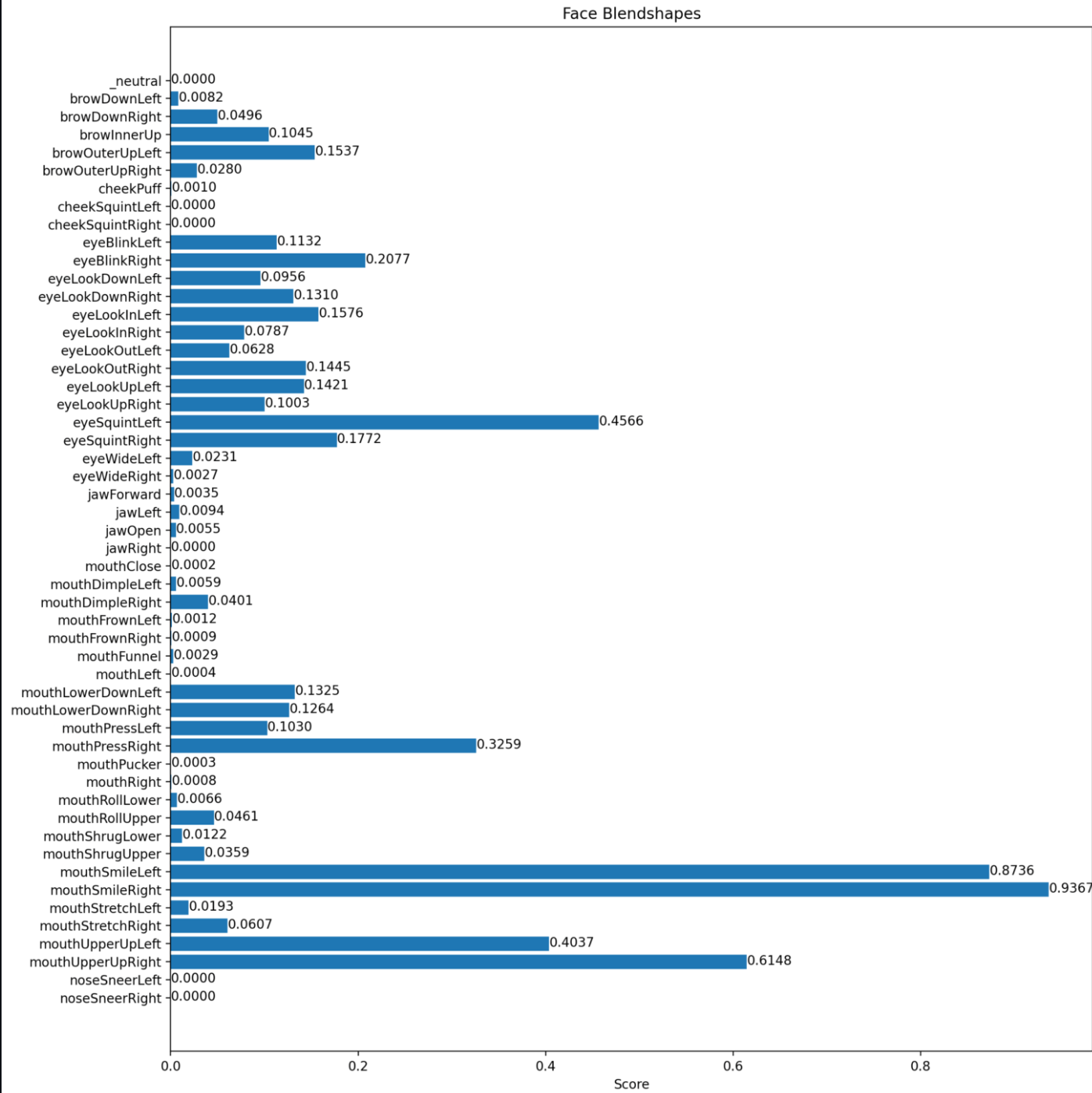🤠
mediapipe + streamlit で BlendShape 推定するメモ
2024 年 4 月時点(v3 preview?)を想定します.
Mediapipe 側の python での呼び出しがちょこちょこ変わっているようです.
model は blendshape weight 推定するのも face_landmarker.task の一つのモデルにまとまっているようです.
とりま試す
streamlit で可視化します.
pyplot 対応とかされているのでぺろっとできます.
import mediapipe as mp
from mediapipe import solutions
from mediapipe.framework.formats import landmark_pb2
import matplotlib.pyplot as plt
import cv2
import numpy as np
import streamlit as st
from PIL import Image
model_path="face_landmarker.task"
BaseOptions = mp.tasks.BaseOptions
FaceLandmarker = mp.tasks.vision.FaceLandmarker
FaceLandmarkerOptions = mp.tasks.vision.FaceLandmarkerOptions
VisionRunningMode = mp.tasks.vision.RunningMode
options = FaceLandmarkerOptions(
base_options=BaseOptions(model_asset_path=model_path),
output_face_blendshapes=True,
running_mode=VisionRunningMode.IMAGE)
img_filename = "alicia2.jpg"
mp_img = mp.Image.create_from_file(img_filename)
# for st
pil_img = Image.open(img_filename)
st.image(pil_img)
with FaceLandmarker.create_from_options(options) as landmarker:
face_landmarker_result = landmarker.detect(mp_img)
st.write(face_landmarker_result)
# From Mediapipe exmaple
def draw_landmarks_on_image(rgb_image, detection_result):
face_landmarks_list = detection_result.face_landmarks
annotated_image = np.copy(rgb_image)
# Loop through the detected faces to visualize.
for idx in range(len(face_landmarks_list)):
face_landmarks = face_landmarks_list[idx]
# Draw the face landmarks.
face_landmarks_proto = landmark_pb2.NormalizedLandmarkList()
face_landmarks_proto.landmark.extend([
landmark_pb2.NormalizedLandmark(x=landmark.x, y=landmark.y, z=landmark.z) for landmark in face_landmarks
])
solutions.drawing_utils.draw_landmarks(
image=annotated_image,
landmark_list=face_landmarks_proto,
connections=mp.solutions.face_mesh.FACEMESH_TESSELATION,
landmark_drawing_spec=None,
connection_drawing_spec=mp.solutions.drawing_styles
.get_default_face_mesh_tesselation_style())
solutions.drawing_utils.draw_landmarks(
image=annotated_image,
landmark_list=face_landmarks_proto,
connections=mp.solutions.face_mesh.FACEMESH_CONTOURS,
landmark_drawing_spec=None,
connection_drawing_spec=mp.solutions.drawing_styles
.get_default_face_mesh_contours_style())
solutions.drawing_utils.draw_landmarks(
image=annotated_image,
landmark_list=face_landmarks_proto,
connections=mp.solutions.face_mesh.FACEMESH_IRISES,
landmark_drawing_spec=None,
connection_drawing_spec=mp.solutions.drawing_styles
.get_default_face_mesh_iris_connections_style())
return annotated_image
def plot_face_blendshapes_bar_graph(face_blendshapes):
# Extract the face blendshapes category names and scores.
face_blendshapes_names = [face_blendshapes_category.category_name for face_blendshapes_category in face_blendshapes]
face_blendshapes_scores = [face_blendshapes_category.score for face_blendshapes_category in face_blendshapes]
# The blendshapes are ordered in decreasing score value.
face_blendshapes_ranks = range(len(face_blendshapes_names))
fig, ax = plt.subplots(figsize=(12, 12))
bar = ax.barh(face_blendshapes_ranks, face_blendshapes_scores, label=[str(x) for x in face_blendshapes_ranks])
ax.set_yticks(face_blendshapes_ranks, face_blendshapes_names)
ax.invert_yaxis()
# Label each bar with values
for score, patch in zip(face_blendshapes_scores, bar.patches):
plt.text(patch.get_x() + patch.get_width(), patch.get_y(), f"{score:.4f}", va="top")
ax.set_xlabel('Score')
ax.set_title("Face Blendshapes")
plt.tight_layout()
#plt.show()
st.pyplot(fig)
annotated_image = draw_landmarks_on_image(mp_img.numpy_view(), face_landmarker_result)
st.image(annotated_image)
plot_face_blendshapes_bar_graph(face_landmarker_result.face_blendshapes[0])
Voila~


TODO
- 動画やカメラ画像対応する
- 出力を JSON-RPC などで出して, 3D model の変形に使う
Discussion